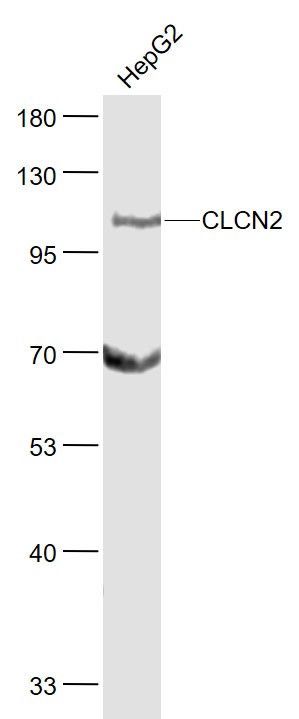
Rabbit Anti-CLCN2 antibody
Chloride Channel 2; Chloride channel protein 2; Chloride channel, voltage sensitive 2; CIC 2; CIC2; ClC-2; CLC2; Clcn2; CLCN2_HUMAN; ECA2; ECA3; EG13; EGI11; EGMA; EJM6; EJM8.
View History [Clear]
Details
Product Name CLCN2 Chinese Name 氯离子Channel protein2抗体 Alias Chloride Channel 2; Chloride channel protein 2; Chloride channel, voltage sensitive 2; CIC 2; CIC2; ClC-2; CLC2; Clcn2; CLCN2_HUMAN; ECA2; ECA3; EG13; EGI11; EGMA; EJM6; EJM8. Research Area Cell biology Neurobiology Signal transduction Channel protein Immunogen Species Rabbit Clonality Polyclonal React Species Human, (predicted: Mouse, Rat, Chicken, Dog, Pig, Cow, Horse, Rabbit, ) Applications WB=1:500-2000 ELISA=1:5000-10000 IHC-F=1:100-500 IF=1:50-200 (Paraffin sections need antigen repair)
not yet tested in other applications.
optimal dilutions/concentrations should be determined by the end user.Theoretical molecular weight 99kDa Cellular localization The cell membrane Form Liquid Concentration 1mg/ml immunogen KLH conjugated synthetic peptide derived from human CLCN2/CLC-2: 501-600/898 Lsotype IgG Purification affinity purified by Protein A Buffer Solution 0.01M TBS(pH7.4) with 1% BSA, 0.03% Proclin300 and 50% Glycerol. Storage Shipped at 4℃. Store at -20 °C for one year. Avoid repeated freeze/thaw cycles. Attention This product as supplied is intended for research use only, not for use in human, therapeutic or diagnostic applications. PubMed PubMed Product Detail The family of voltage-dependent chloride channels (CLCs) regulate cellular trafficking of chloride ions, a critical component of all living cells. CLCs regulate excitability in muscle and nerve cells, aid in organic solute transport and maintain cellular volume. The genes encoding human CLC-1 through CLC-7 map to chromosomes 7q32, 3q28, 4q32, Xp22.3, Xp11.23-p11.22, 1p36 and 16p13, respectively. CLC1 is highly expressed in skeletal muscle. Mutations in the gene encoding CLC1 lead to myotonia, an inheritable disorder characterized by muscle stiffness and renal salt wasting. CLC2 is highly expressed in the epithelia of several organs including lung, which suggests CLC2 may be a possible therapeutic target for cystic fibrosis. CLC3 expression is particularly abundant in neuronal tissue, while CLC4 expression is evident in skeletal and cardiac muscle as well as brain. Mutations in the gene encoding CLC5 lead to Dent’s disease, a renal disorder characterized by proteinuria and hypercalciuria. CLC6 and CLC7 are broadly expressed in several tissues including testis, kidney, brain and muscle.
Function:
Voltage-gated chloride channel. Chloride channels have several functions including the regulation of cell volume; membrane potential stabilization, signal transduction and transepithelial transport.
Subcellular Location:
Membrane; Multi-pass membrane protein.
Tissue Specificity:
Ubiquitously expressed. Moderately expressed in aortic and coronary vascular smooth muscle cells and expressed at a low level in aortic endothelial cells.
DISEASE:
Defects in CLCN2 are associated with susceptibility to epilepsy, idiopathic generalized type 11 (EIG11) [MIM:607628]. A disorder characterized by recurring generalized seizures in the absence of detectable brain lesions and/or metabolic abnormalities. Generalized seizures arise diffusely and simultaneously from both hemispheres of the brain.
Defects in CLCN2 are associated with juvenile absence epilepsy type 2 (JAE2) [MIM:607628]. JAE is a subtype of idiopathic generalized epilepsy (IGE) characterized by onset occurring around puberty, absence seizures, generalized tonic-clonic seizures (GTCS), GTCS on awakening and myoclonic seizures.
Defects in CLCN2 are associated with juvenile myoclonic epilepsy type 8 (EJM8) [MIM:607628]. A subtype of idiopathic generalized epilepsy. Patients have afebrile seizures only, with onset in adolescence (rather than in childhood) and myoclonic jerks which usually occur after awakening and are triggered by sleep deprivation and fatigue.
Similarity:
Belongs to the chloride channel (TC 2.A.49) family. ClC-2/CLCN2 subfamily.
Contains 2 CBS domains.
SWISS:
P51788
Gene ID:
1181
Database links:Entrez Gene: 1181 Human
Entrez Gene: 12724 Mouse
Omim: 600570 Human
SwissProt: P51788 Human
SwissProt: Q6IPA9 Human
SwissProt: Q9R0A1 Mouse
Unigene: 436847 Human
Unigene: 177761 Mouse
Unigene: 11073 Rat
Product Picture
References (0)
No References
Bought notes(bought amounts latest0)
No one bought this product
User Comment(Total0User Comment Num)
- No comment



 +86 571 56623320
+86 571 56623320
 +86 18668110335
+86 18668110335

